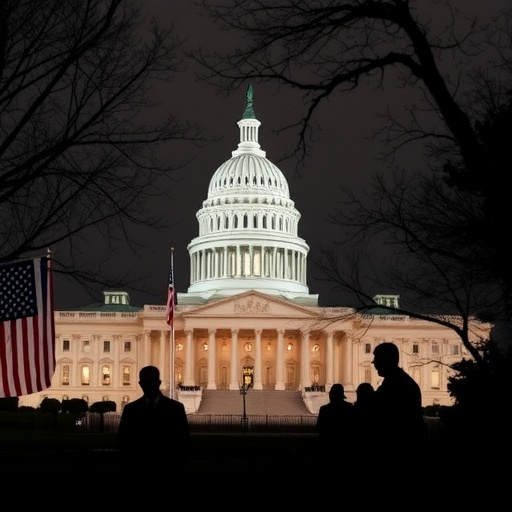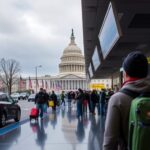Senate Funding Deadlock Drags On: Looming Vote on Government Spending Bill Sparks Bipartisan Tensions
In a high-stakes standoff that’s gripping Washington, the U.S. Senate remains locked in a government funding deadlock, with lawmakers from both sides of the aisle digging in their heels as a pivotal vote on a temporary spending bill approaches. Just days away from a potential partial government shutdown, negotiations have stalled over contentious policy riders that could reshape everything from immigration enforcement to environmental regulations. This impasse threatens to disrupt federal operations nationwide, leaving millions of Americans wondering if essential services will grind to a halt.
The latest developments come after a marathon session late last week, where Senate Majority Leader Chuck Schumer (D-NY) pushed for a clean continuing resolution to avert a shutdown, only to face fierce opposition from Republicans demanding attachments to the bill. With the current funding deadline expiring at midnight on Friday, the chamber is bracing for what could be another all-nighter, echoing the chaotic votes of recent years that have become all too familiar in Capitol Hill’s funding battles.
At the heart of the dispute are deep-seated disagreements on spending priorities, including billions in allocations for defense, disaster relief, and social programs. Democrats argue that attaching ideological policy riders—provisions that bundle unrelated legislation into must-pass funding measures—undermines the legislative process and risks unnecessary economic fallout. Republicans, however, see these riders as essential tools to advance their agenda on border security and fiscal restraint, refusing to budge without concessions.
Policy Riders Ignite Fierce Partisan Firestorm
The policy riders at the center of this Senate deadlock are no small potatoes; they’re loaded with politically charged measures that could dramatically alter federal priorities. One of the most contentious is a Republican-backed rider that would allocate an additional $10 billion for border wall construction along the U.S.-Mexico border, tying it directly to the spending bill. Proponents, led by Sen. Ted Cruz (R-TX), claim it’s vital for national security amid record migrant encounters, citing U.S. Customs and Border Protection data showing over 2.4 million apprehensions in fiscal year 2023.
“We’re not going to fund a government that leaves our borders wide open,” Cruz declared during a fiery floor speech on Tuesday. “This rider isn’t optional—it’s a non-negotiable safeguard for American families.”
Democrats, including Sen. Dick Durbin (D-IL), the chamber’s No. 2 Democrat, have slammed the proposal as a blatant attempt to hijack government funding for partisan gains. Durbin pointed to a Congressional Budget Office analysis estimating that such riders could inflate the bill’s cost by up to 15%, diverting resources from critical areas like veterans’ healthcare and infrastructure repairs. “These aren’t riders; they’re anchors dragging down our economy,” Durbin said in an interview with The Washington Post. “The American people deserve a government that works, not one held hostage by extremists.”
Another flashpoint is a Democratic push for a rider extending protections for clean energy tax credits under the Inflation Reduction Act, which Republicans decry as “green pork.” This provision, valued at $5 billion, aims to sustain job growth in renewable sectors, with the Department of Energy reporting over 100,000 new positions created since the law’s passage. Yet, GOP leaders like Senate Minority Leader Mitch McConnell (R-KY) have vowed to block any bill including it, arguing it exacerbates inflation—now hovering at 3.2% according to the latest Bureau of Labor Statistics figures.
The back-and-forth has led to procedural gridlock, with filibuster threats and amendment wars consuming precious hours. Senate Parliamentarian Elizabeth MacDonough has already ruled several proposed riders out of order, forcing lawmakers to scramble for workarounds and intensifying the deadlock.
Federal Agencies on Edge as Shutdown Specter Looms
As the Senate grapples with this funding crisis, federal agencies across the board are activating contingency plans, preparing for the worst. A partial shutdown would furlough hundreds of thousands of non-essential workers and halt operations that touch every corner of American life—from national parks to air traffic control. The Office of Personnel Management estimates that the last major shutdown in 2018-2019 cost the economy $11 billion, a figure that’s likely to climb higher today given inflation and expanded government roles.
Take the Department of Veterans Affairs (VA), for instance. With over 400,000 employees, the VA has warned that a funding lapse could delay benefit payments to 5 million veterans, including disability compensation and pensions. VA Secretary Denis McDonough issued a memo this week outlining phased responses, starting with mandatory telework for 80% of staff. “Our mission to serve those who’ve served us doesn’t stop, but without funding, our ability to deliver does,” McDonough stated in a press briefing.
Similarly, the National Institutes of Health (NIH) faces disruptions in groundbreaking research. Ongoing clinical trials for cancer treatments and vaccine development could pause, affecting partnerships with universities and private firms. A 2022 Government Accountability Office report highlighted how previous shutdowns delayed NIH grants by an average of three months, costing an estimated $500 million in lost productivity.
Small business owners are also feeling the pinch. The Small Business Administration (SBA), which processes disaster loans for hurricane-hit regions like Florida and North Carolina, has $2.5 billion in pending applications. Without government funding, these loans—crucial for rebuilding after storms like Hurricane Idalia—could stall, exacerbating economic recovery challenges. “We’re already underwater from the floods; a shutdown would drown us,” said Maria Gonzalez, owner of a Miami-based construction firm, in a statement to Reuters.
Public health experts warn of broader ripple effects. The Centers for Disease Control and Prevention (CDC) might suspend routine disease surveillance, potentially missing early signs of outbreaks like avian flu, which has already infected dairy cows in eight states per USDA reports. This uncertainty is amplifying anxiety among state governments, many of which rely on federal matching funds for Medicaid and education programs.
Senators’ Heated Exchanges Expose Deep Divisions
Inside the marbled halls of the Capitol, the deadlock has fueled some of the most acrimonious debates in recent memory. Moderates from both parties have attempted to broker deals, but ideological hardliners are holding firm. Sen. Susan Collins (R-ME), a key swing vote, emerged from a closed-door meeting on Wednesday expressing cautious optimism but frustration. “We’ve got to peel away the policy riders that are poisoning the well,” Collins told reporters. “A clean bill is the only path forward to protect our constituents from this manufactured crisis.”
On the Democratic side, Sen. Kyrsten Sinema (I-AZ), who caucuses with Democrats, has been vocal about the need for compromise, drawing from her experience in past funding fights. In a Politico op-ed published yesterday, Sinema wrote, “The Senate was designed for deliberation, not demolition. Attaching riders to a spending bill isn’t governance; it’s gamesmanship that hurts real people.” Her words resonated with independents and some Republicans, but party leaders dismissed them as insufficiently tough.
House Speaker Mike Johnson (R-LA) has weighed in from across the rotunda, urging the Senate to mirror the House’s version of the bill, which includes steeper cuts to non-defense discretionary spending—slashing it by 22% as proposed in the Fiscal Responsibility Act. Johnson tweeted, “Time for the upper chamber to step up and secure our borders with real funding, not empty promises.” This has only widened the rift, as House Democrats boycotted a recent vote in solidarity with Senate progressives.
Behind the scenes, lobbyists from industries like tech, agriculture, and defense are flooding Capitol Hill with calls. The U.S. Chamber of Commerce issued a statement warning that prolonged uncertainty could shave 0.5% off GDP growth in the fourth quarter, based on Moody’s Analytics projections. Meanwhile, progressive groups like the Sierra Club are rallying against environmental rollbacks hidden in riders, organizing virtual town halls with over 50,000 participants this week.
Lessons from Past Funding Fiascos Shape Current Strategy
This isn’t the first time the Senate has teetered on the brink of shutdown over government funding. Historical precedents abound, offering stark reminders of the costs involved. In 2013, a 16-day shutdown over the Affordable Care Act furloughed 800,000 workers and closed landmarks like the Smithsonian museums, costing $24 billion according to the Pew Research Center. More recently, the 35-day shutdown in late 2018—sparked by wall funding demands—led to 800,000 federal employees missing paychecks, with many dipping into savings or relying on food banks.
Those episodes have informed current tactics. Democrats, scarred by the 2018 fallout, are emphasizing bipartisan infrastructure wins from the 2021 Bipartisan Infrastructure Law, which has funneled $50 billion into roads and bridges without riders. Republicans, drawing from the 2013 playbook, are leveraging public opinion on immigration, where Gallup polls show 55% of Americans favor stronger border measures.
Yet, experts note a key difference this time: the shadow of the 2024 elections. With control of Congress and the White House in play, neither party wants to own a shutdown. Political analyst Norman Ornstein of the American Enterprise Institute observed, “The deadlock is real, but so is the incentive to blink first. Expect horse-trading behind closed doors as the clock ticks.” Ornstein’s commentary, featured on NPR, underscores how electoral math could force a breakthrough.
Additionally, external pressures are mounting. The Federal Reserve’s recent decision to hold interest rates steady at 5.25-5.50% has Wall Street jittery about fiscal instability, with the Dow Jones dipping 1.2% on news of the stalled vote. International allies, including the EU, have expressed concern over U.S. reliability in global aid commitments, such as Ukraine support, which is bundled into the broader spending bill.
Path Forward: Negotiations Intensify with Shutdown Deadline Nearing
As the Senate hurtles toward its next vote—scheduled for Thursday evening—the pressure is on for last-ditch negotiations. White House officials, including Chief of Staff Jeff Zients, have been shuttling between the Capitol and the Oval Office, proposing a stripped-down spending bill that delays rider debates until the new year. President Biden addressed the nation in a brief Rose Garden remarks, stating, “Congress has the power to keep the lights on for the American people. Let’s get it done without the drama.”
Potential compromises include a short-term extension of current funding levels—perhaps through March—paired with a bicameral committee to tackle policy riders separately. Sen. Lindsey Graham (R-SC), a senior Republican, hinted at flexibility during a CNN appearance, saying, “If Democrats drop the extreme green spending, we can talk borders.” Such signals suggest a deal might emerge, but skeptics abound.
Looking ahead, the implications of this deadlock could reverberate far beyond this week. A successful vote would provide breathing room for tackling larger issues like the debt ceiling, due to hit in January. Failure, however, might trigger not just a shutdown but a cascade of legal challenges and economic tremors, with Fitch Ratings warning of a possible U.S. credit downgrade if volatility persists.
Stakeholders from coast to coast are watching closely. Farmers in the Midwest, awaiting $20 billion in farm bill extensions, and tech innovators in Silicon Valley, dependent on NIH grants, are among those urging swift action. As one anonymous Senate aide put it, “This isn’t just about D.C.—it’s about every paycheck, every program, every promise we’ve made to the public.” With the vote looming, the Senate‘s next move will define not only government funding but the chamber’s ability to function in an era of hyper-partisanship.









